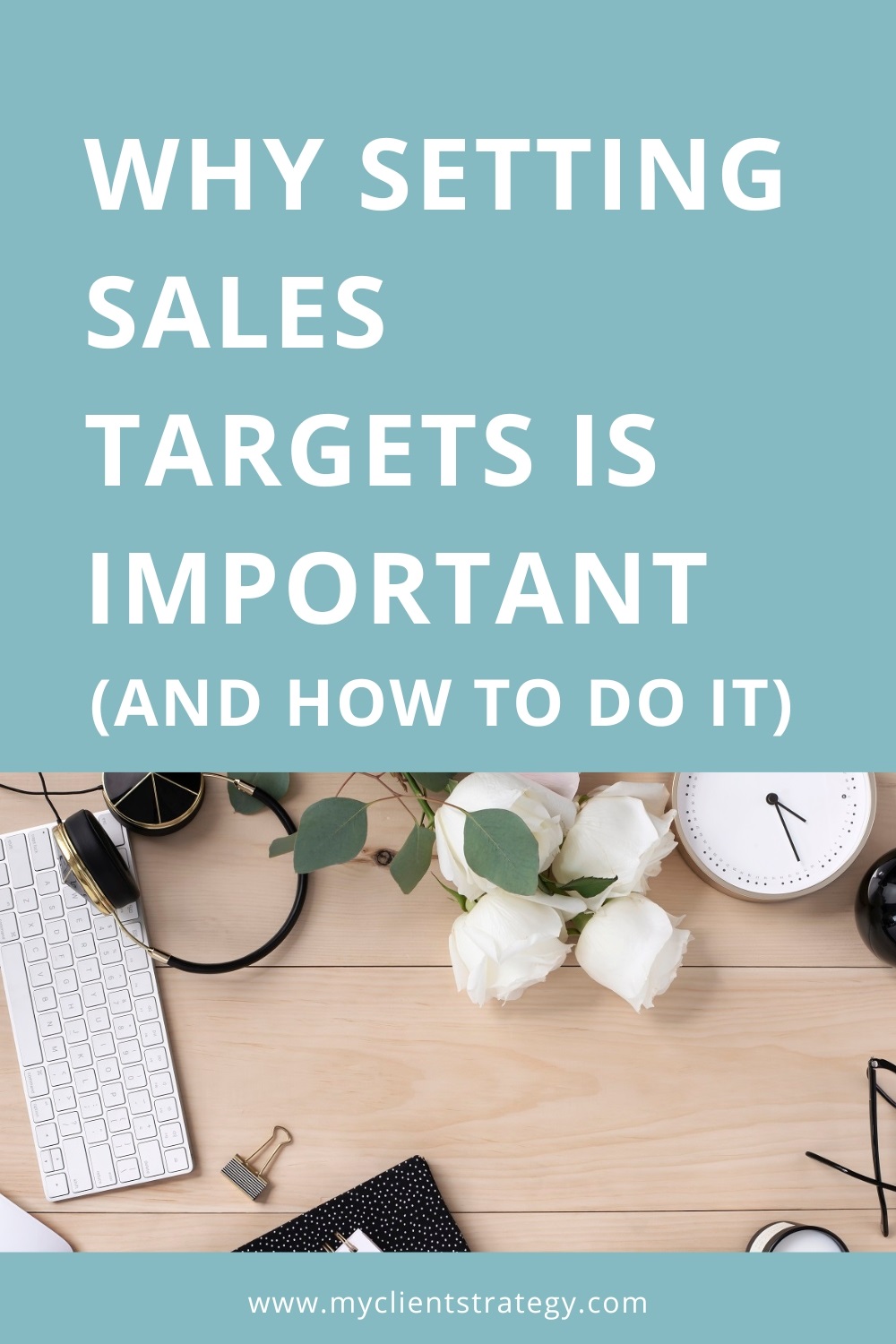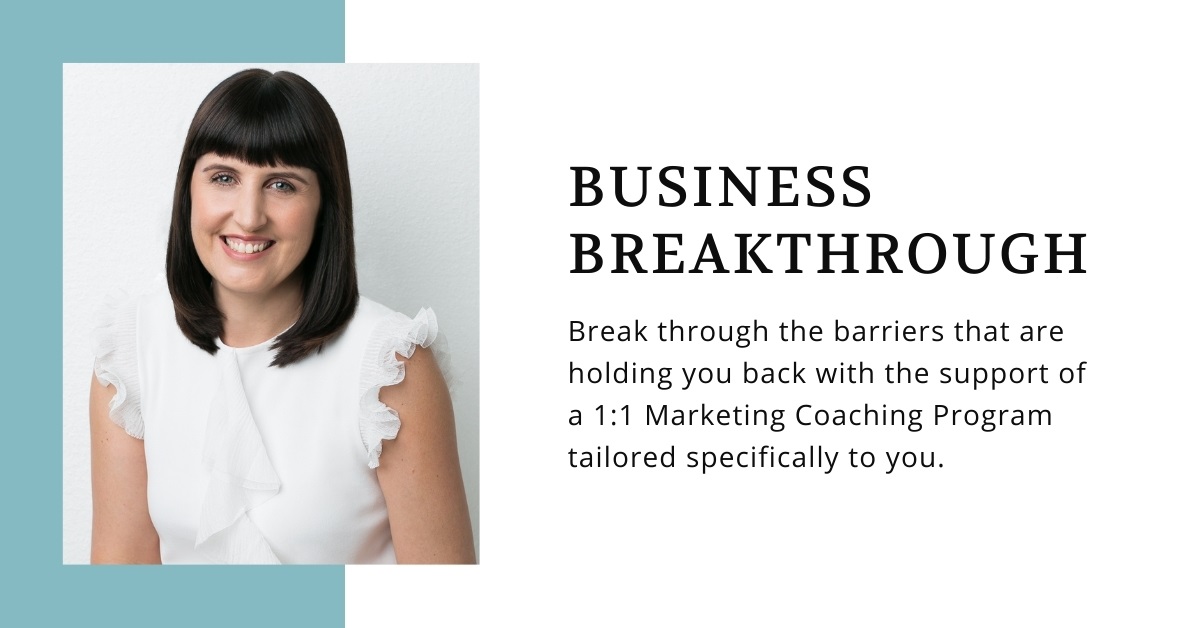Why setting sales targets is important (And how to do it)

When creating a marketing strategy and plan – so you can attract consistent clients and grow – I want you to know that it’s super important to set sales targets.
And I know just how hard (and scary) it can be to decide where to set that sales target for your service business… especially when the revenue you probably want to hit feels so far out of reach today.
However, here’s the thing:
Your sales target enables you to get that all-important CLARITY you need to measure, track, and improve your business performance.
It guides and supports you in making intentional decisions about what to include or adjust in your marketing strategy and plan.
And your sales target helps you to stop floating around aimlessly in your business with the hope that you might one day achieve your income goals.
Instead, it gets you to start putting all your energy and motivation into the essential revenue-generating activities you need to grow!

I know just how much of a difference setting sales targets can make in a business because it’s something that I used to do a lot of in my corporate life to help focus our sales teams.
I’ve seen members of the My Client Strategy Academy benefit from setting sales targets during our quarterly goal-setting and planning sessions.
And it’s one of the first things I help my Business Breakthrough clients with when we start working together, so they’re set up for success throughout their 1:1 coaching program.
So, if you’ve been avoiding setting a sales target for your business because you think it’s nearly impossible to reach it.
Or if you’re struggling with how and where to set your sales goal, then that’s where I can help.
Below, you’ll find my small business advice for those who aren’t sure where to start when it comes to setting sales targets.
I also outline your options to close any sales gaps and achieve your longer-term revenue goals.
Ready? Before I jump into my advice, let’s start with an overview of sales targets and why they are super important.
What is a sales target?
A sales target is a specific amount of dollars or units you want to sell in your service business within a defined period.
Commonly, sales targets are set annually, and then (depending on the type of business), they can be broken down into smaller quarterly, monthly, weekly, and even daily volumes.
These smaller volumes help you focus on your immediate sales priorities and make the sales targets feel more achievable.
Why are sales targets important?
You need to include a sales target in your marketing strategy and plan because it gives you something to measure against your sales results.
And when you can measure your sales against your targets, you’ll be better informed when deciding what to do next to enhance and improve your performance.
For example, you may have a specific service that’s not selling as well as your other services, creating a gap in your sales performance.
With this information, you can make changes to that specific service to drive more sales.
You may also realise that you haven’t been promoting that service enough to reach your sales goal and need to give it more visibility.
Alternatively, you may decide that it’s a service with little demand.
So, you could decide to stop offering the service or make some changes to it, so it’s more appealing to your clients.
RELATED: 7 Marketing metrics every service business should track
Not sure where to start when it comes to marketing your service-based small business? That’s where I can help. Get started by downloading my free Ultimate Marketing Checklist by clicking the button below:
Where do you start when it comes to setting your sales target?
I’ve helped many small business owners set sales targets for their businesses.
And one of the most common mistakes I see is people setting targets without using a methodology.
They randomly choose a number, like $5,000 months or a $100,000 year.
Many people also start out with the aim of replacing their corporate salary in their first year in business.
The thing is… unless you’ve been working away on your side hustle for quite some time or are buying into an already established business, it’s very challenging to start making a lot of money from scratch in your first year.
This is why, if you’re just starting your business, I recommend setting a sales target that covers your expenses.
This target should include a combination of your personal and business expenses and will be the minimum revenue you need to make to ensure a sustainable business.
It’s your break-even point and the number at which you can start making a profit after that.
It’s also usually a lot smaller and more realistic sales target which means it will be easier to achieve than trying to replace your salary in the first year.
My other advice when setting your sales target is to put some meaning behind your sales numbers.
For example, if you have a break-even target of $2,500 a month and want to set a stretch goal that includes another $500 profit each month, then identify what you’ll do with that $500.
Will you save up to buy a new car or put it towards a holiday for your family?
Or reinvest that money back into your business to drive growth?
When you have specific goals that hold meaning, it makes it much more motivating to try and reach your sales targets and will help you achieve success faster.
RELATED: 7 Steps to setting marketing goals you’ll actually achieve

Many small business owners also create a sales plan that defines their sales targets at a more detailed level to provide better sales tracking and insights.
This targeting could include by service type, geography, or sales channel through which the service was sold, depending on the size and complexity of the business.
At a minimum, I recommend that your sales plan contains sales targets for each service type.
Or if you have more than five or so services, then at a service category level, so you don’t add too much complexity.
For example, if you sell consultations, courses, and training programs, you would split your sales target for the timeframe down into three targets – one for each service type you sell.
These separate sales targets will enable you to measure and track your performance for each service, giving valuable insights into what’s working (and what’s not).
It will also assist you when it comes to deciding what actions you may take to close any revenue gaps that appear in future.
Not sure where to start when it comes to marketing your service-based small business? That’s where I can help. Get started by downloading my free Ultimate Marketing Checklist by clicking the button below:
So, now that you’ve set your sales goal, allocated your sales targets by service type, and started selling, what should you do if you identify a sales gap?
Well, there are three main ways to close a sales gap in your service business:
1. Increase your sales volume
When you analyse your sales performance, consider if there’s an opportunity to increase the number of units you’re selling.
It may be that you simply don’t have enough awareness or visibility on your offer to reach your sales target.
Or you might be able to adjust something in your sales process to increase your conversion rate and close more sales.
You could also potentially target a new type of client to increase your sales volumes or another geographical area.
2. Introduce a new service
Another way to close your sales gap is to consider introducing a new service to your business.
This may be a brand-new service offering or an adaption on something you’re already selling.
Something relatively easy to add is a higher-priced VIP level on an existing service that’s over and above your standard offer.
3. Raise your prices
Whilst it can sometimes feel uncomfortable to raise your prices, it’s another effective way to close a sales revenue gap.
For tips on how to effectively communicate a price increase, check out my blog post here:
5 Tips for communicating a price increase to your clients
One of these sales growth strategies above may appeal to you more, or you could apply some or all of these to your services.
To summarise, it’s important to set sales targets for your service business to have the data and insights you’ll need to measure, track, and enhance your sales performance effectively.
I’ve also outlined how you can start setting a realistic and achievable sales target for your small business.
And I’ve provided some advice on how you can set targets to keep you focused and motivated to grow your service business.
Tired of trying to figure out what you’re missing when it comes to finding clients and making sales in your service business?
Break through the barriers that are holding you back with the support of an MBA-qualified Marketing Coach and Business Mentor who will tailor a 1:1 program specifically for you.

BUSINESS BREAKTHROUGH is my signature 6-month 1:1 Coaching Program for service-based business owners who want to develop the strategy, systems, and structure they need to find clients and make sales, so they can stop feeling stuck and start gaining massive momentum in their business.
Did you find this blog post helpful? Don’t forget to PIN to Pinterest and share on Facebook.



